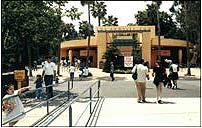Using Cool Pavements to Reduce Heat Islands
Cool pavements include a range of established and emerging technologies that communities are exploring as part of their heat island reduction efforts. The term currently refers to paving materials that reflect more solar energy, enhance water evaporation, or have been otherwise modified to remain cooler than conventional pavements.
Conventional paving materials can reach peak summertime temperatures of 120–150°F (48–67°C), transferring excess heat to the air above them and heating stormwater as it runs off the pavement into local waterways. Due to the large area covered by pavements in urban areas (nearly 30–45% of land cover based on an analysis of four geographically diverse cities1), they are an important element to consider in heat island mitigation.
Cool pavements can be created with existing paving technologies (such as asphalt and concrete) as well as newer approaches such as the use of coatings or grass paving. Cool pavement technologies are not as advanced as other heat island mitigation strategies, and there is no official standard or labeling program to designate cool paving materials. To help address the growing demand for guidance on pavement choices, the Transportation Research Board has formed a subcommittee on Paving Materials and the Urban ClimateExit. The subcommittee's scope includes modeling, design practices, testing, standards development, and planning and policy considerations.
Benefits and Costs
In addition to reducing heat islands, the benefits of cool pavements include:
- Reduced stormwater runoff and improved water quality: Permeable pavements can allow stormwater to soak into the pavement and soil, reducing runoff and filtering pollutants. Both permeable and non-permeable cool pavements can also help lower the temperature of runoff, resulting in less thermal shock to aquatic life in the waterways into which stormwater drains.
- Lower tire noise: The open pores of permeable pavements can reduce tire noise by two to eight decibels and keep noise levels below 75 decibels, although noise reduction may decline over time.2
- Enhanced safety: Permeable roadway pavements can improve safety by reducing water spray from moving vehicles and increasing traction through better water drainage.
- Better nighttime visibility: Reflective pavements can enhance visibility at night, potentially reducing lighting requirements and saving both money and energy.
- Improved local comfort: Cool pavements in parking lots or other areas where people congregate or children play can provide a more comfortable environment.
Comparing the costs of cool pavements with those of conventional paving materials is difficult. The cost of any pavement application varies by region, the contractor, the time of year, materials chosen, accessibility of the site, local availability of materials, underlying soils, size of the project, expected traffic, and the desired life of the pavement.
Communities that want to use cool pavements as part of a heat island mitigation program may find it hard to estimate the net costs or benefits based on temperature reduction alone. The greatest overall value may result when multiple benefits, such as improved stormwater management and water quality, are factored into the evaluation of a paving approach.
For More Information
More details are available in the Cool Pavements chapter of EPA’s Reducing Urban Heat Islands: Compendium of Strategies, which covers the following topics:
- How cool pavements work
- Potential cool pavement types
- Benefits and costs of cool pavements
- Cool pavements initiatives
- Resources for more information
References
1. Akbari, H., L. Rose, and H. Taha. 1999. Characterizing the Fabric of the Urban Environment: A Case Study of Sacramento, California (PDF) (65 pp, 6MB). Paper LBNL-44688. Lawrence Berkeley National Laboratory. Also: Rose, L., H. Akbari, and H. Taha. 2003. Characterizing the Fabric of the Urban Environment: A Case Study of Greater Houston, Texas (PDF) (65 pp, 4.5MB). Paper LBNL-51448. Lawrence Berkeley National Laboratory.
2. Glazier, G. and S. Samuels. 1991. Effects of Road Surface Texture on Traffic and Vehicle Noise. Transportation Research Record 1312:141-44.

